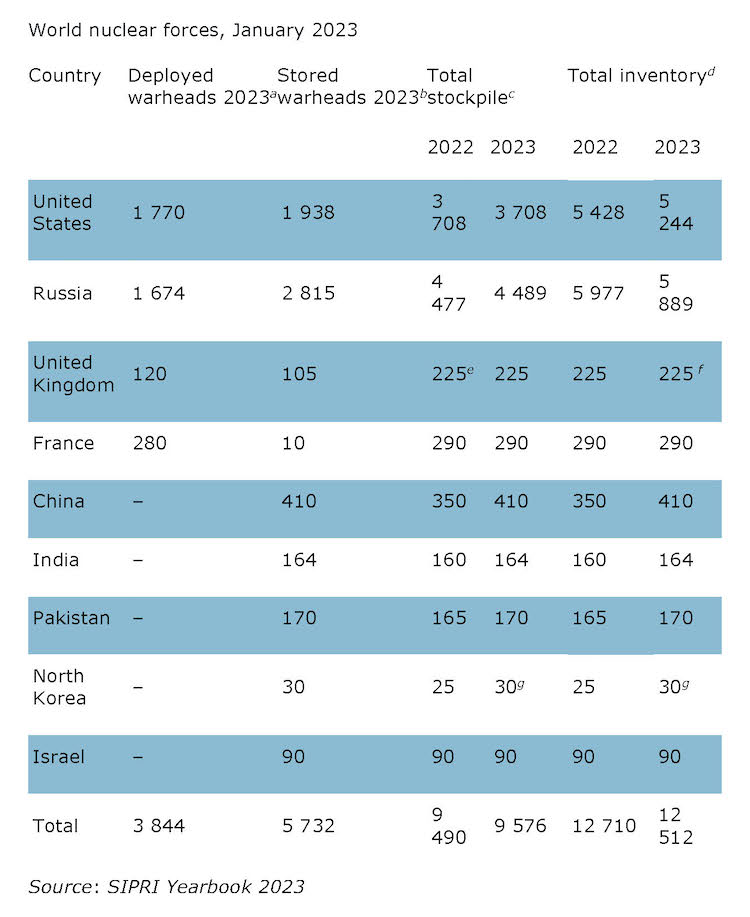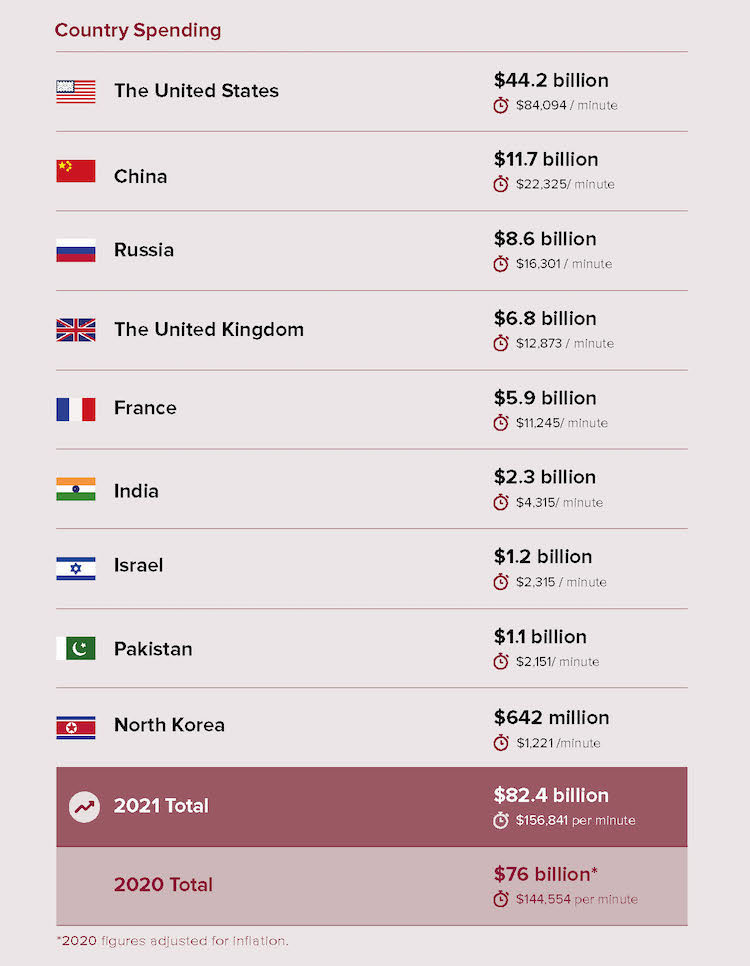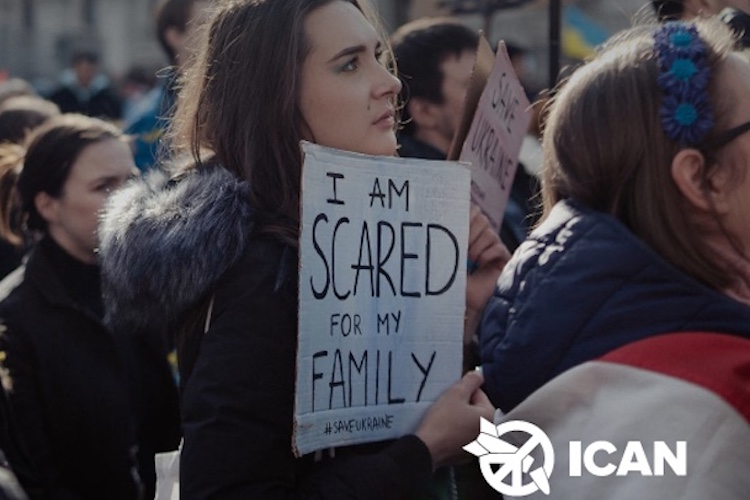By Thalif Deen
UNITED NATIONS, 12 June 2023 (IDN) — As geopolitics take a turn for the worse—with Russian nuclear threats in Ukraine, the saber-rattling by North Korea and the increasing political confrontation between the US and China—there are rising investments in the world’s expanding nuclear arsenals.
Global spending on nuclear weapons increased in 2022 for the third year in a row as the nine nuclear-armed states continued to modernize and expand their arsenals.
According to a June 12 report from the International Campaign to Abolish Nuclear Weapons (ICAN), nuclear arsenals are being fortified around the world.
The world’s nine nuclear-armed states—the US, Russia, the UK, France, China, India, Pakistan, the Democratic People’s Republic of Korea (North Korea) and Israel—continue to modernize their nuclear arsenals while Russia or the US— were kept in a state of high operational alert, fitted to missiles or held at airbases hosting nuclear bombers.
Collectively, the nine countries spent $82.9 billion, 3% more than in 2021—$157,664 spent per minute on nuclear arms in 2022, according to ICAN, which produces some of the most authoritative figures on nuclear weapons expenditures.
The report, Wasted: 2022 Global Nuclear Weapons Spending, shows that the United States spent $43.7 billion. Although this was slightly less than in 2021, the US continues to spend more than all the other nuclear-armed countries* put together.
China spent a quarter of the US total at $11.7 billion, an increase of just over 6%. Russia was the third largest spender at $9.6 billion, which represents an increase of 5.74% on the previous year.
The country that increased the most was India with a 21.8% increase. The other country that had a double-digit rise was the UK which increased spending by just over 11%.
Meanwhile, the Stockholm International Peace Research Institute (SIPRI) launched its annual assessment of the state of armaments, disarmament and international security.
A key finding of SIPRI Yearbook 2023, released June 12, is that the number of operational nuclear weapons started to rise as countries’ long-term force modernization and expansion plans progressed.
Russia and the US together possess almost 90 per cent of all nuclear weapons. The sizes of their respective nuclear arsenals (i.e., useable warheads) seem to have remained relatively stable in 2022, although transparency regarding nuclear forces declined in both countries in the wake of Russia’s invasion of Ukraine in February 2022.
In addition to their useable nuclear weapons, Russia and the US each hold more than 1000 warheads previously retired from military service, which they are gradually dismantling.
SIPRI’s estimate of the size of China’s nuclear arsenal increased from 350 warheads in January 2022 to 410 in January 2023, and it is expected to keep growing. Depending on how it decides to structure its forces, China could potentially have at least as many intercontinental ballistic missiles (ICBMs) as either the US or Russia by the turn of the decade.
Jackie Cabasso, Executive Director, Western States Legal Foundation in Oakland, California, which monitors and analyzes US nuclear weapons programs and policies, told IDN over one hundred years ago, an Austrian sociologist and political activist named Rudolph Goldscheid wrote, “The budget is the skeleton of the state stripped of all misleading ideologies.”
The new ICAN report on global nuclear weapons spending, alongside the recent report from SIPRI on global military spending, exposes the truly violent ideologies held by the world’s nine nuclear-armed states and their allies, she said.
According to SIPRI, in 2022, world military expenditures climbed to a record high of $2240 billion, with the U.S. accounting for 39% of global military spending, more than the next ten countries combined, more than ten times as much as Russia, and three times as much as China.
The $1.6 trillion discretionary spending request in the White House’s proposed Budget for FY 2024 includes $886 billion for the military, near historically high levels. More than half of the proposed discretionary spending is for the military and war, and only one in three federal discretionary dollars would be available for human needs and community programs, Cabasso pointed out.
The US President’s FY 2024 Budget request fully funds implementation of the 2022 Nuclear Posture Review, which includes the planned replacement of the entire “nuclear triad” of intercontinental ballistic missiles, ballistic missile submarines, and long-range bombers with new systems.
Yet an independent audit by the Poor People’s Campaign: A National Call for Moral Revival, before the pandemic, found that in the United States, the richest country in history, 140 million Americans were living in poverty or one emergency away from economic ruin, representing 43% of the nation’s population and 52% of its children.
“The hard truth is that neither the Nuclear Nonproliferation Treaty nor the Treaty on the Prohibition of Nuclear Weapons can achieve disarmament for the foreseeable future because none of the nuclear-armed states are willing to reimagine a global system based on “common security,” rather than nuclear coercion – euphemistically called deterrence,” she noted.
The nuclear weapons budget and the military budget more broadly are about more than just morality or guns vs. butter tradeoffs.
“We also need to be cognizant of the purposes and interests that nuclear weapons and militarism serve, and how perpetual war preparations manifest a culture of violence that runs from the top to the bottom of our society”.
“We need to fundamentally challenge the dominant definition of “national security” through military means, at any cost. What’s needed now is nothing less than a global paradigm shift that prioritizes universal human security and environmental preservation over endless material growth ensured by overwhelming military might that benefits the few at the expense of the vast majority of humankind,” Cabasso declared.
Hans Kristensen, Associate Senior Fellow with SIPRI’s Weapons of Mass Destruction Programme, told IDN the trend is that nuclear weapons numbers, types, investments, and rhetoric are increasing. Because the factors that drive this development are tied to crises and even wars, it is likely that nuclear risks will continue to grow in the foreseeable future.
Asked about the UN’s longstanding demand for a cut in global military spending, Kristensen said: “Although it is difficult to influence nuclear weapons spending and behaviors is important to continue to push for responsible changes”.
“I think it is fair to say that the world – and with it the UN community – is facing its greatest nuclear weapons challenge since the end of the Cold a war” said Kristensen, who is also Director of the Nuclear Information Project at the Federation of American Scientists (FAS).
“China has started a significant expansion of its nuclear arsenal. It is increasingly difficult to square this trend with China’s declared aim of having only the minimum nuclear forces needed to maintain its national security,” he added.
Although the UK is not thought to have increased its nuclear weapon arsenal in 2022, the warhead stockpile is expected to grow in the future as a result of the British government’s announcement in 2021 that it was raising its limit from 225 to 260 warheads, according to SIPRI.
The government also said it would no longer publicly disclose its quantities of nuclear weapons, deployed warheads or deployed missiles.
In 2022, France continued its programmes to develop a third-generation nuclear-powered ballistic missile submarine (SSBN) and a new air-launched cruise missile, as well as to refurbish and upgrade existing systems. 
All estimates are approximate. SIPRI revises its world nuclear forces data each year based on new information and updates to earlier assessments. The data for Jan. 2023 replaces all previously published SIPRI data on world nuclear forces. Countries are ordered by date of first known nuclear test. There is no conclusive open-source evidence that Israel has tested its nuclear weapons. The figures for Russia and the US do not necessarily correspond to those in their 2010 Treaty on Measures for the Further Reduction and Limitation of Strategic Offensive Arms (New START) declarations because of the treaty’s counting rules.
a‘Deployed warheads’ refers to warheads placed on missiles or located on bases with operational forces.b‘Stored warheads’ refers to stored or reserve warheads that would require some preparation (e.g. transport and loading on to launchers) before they could be deployed ‘Total stockpile’ refers to warheads that are intended for use by the armed forces. d‘Total inventory’ includes both stockpiled warheads and retired warheads awaiting dismantlement. eSIPRI previously estimated that the UK had about 45 retired warheads awaiting dismantlement; however, SIPRI’s assessment as of Jan. 2023 is that these warheads are likely to be reconstituted to become part of the UK’s growing stockpile over the coming years and the stockpile number remained at 225 in Jan. 2022.f
The British government declared in 2010 that its nuclear weapon inventory would not exceed 225 warheads. It is estimated here that the inventory remained at that number in Jan. 2023. A planned reduction to an inventory of 180 warheads by the mid-2020s was ended by a government review published in 2021. The review introduced a new ceiling of 260 warheads.g Information about the status and capability of North Korea’s nuclear arsenal comes with significant uncertainty. North Korea might have produced enough fissile material to build 50–70 nuclear warheads; however, it is likely that it has assembled fewer warheads, perhaps around 30.
ICAN’s Programme Coordinator and co-author of the report, Susi Snyder said: “It’s appalling that these nine countries spent $82.9 billion on 12,500 nuclear weapons. These billions could have been spent on rebuilding from the devastating COVID 19 pandemic and combating climate change and biodiversity loss”.
“The arms industry is raking in about 35% of this money while telling shareholders that lobbying against nuclear disarmament is good for business. But thankfully more and more investors are coming to see nuclear weapons as a significant risk and are divesting from these companies.” she said
Alicia Sanders-Zakre, co-author of the report and Policy and Research Coordinator at ICAN said: “Nuclear-armed states increase spending every year, but the $82.9 billion they wasted in 2022 did nothing to improve global security, rather, they are making the situation worse.”
She said real security is being provided through the Treaty on the Prohibition of Nuclear Weapons, where almost half of UN member states are rejecting these tools of terror and intimidation and collaborating to end the nuclear weapons era forever.”
You can download the full ICAN report here
 [IDN-InDepthNews]
[IDN-InDepthNews]
Image credit: ICAN
Visit us on Facebook and Twitter.
IDN is the flagship agency of the Non-profit International Press Syndicate.
We believe in the free flow of information. Republish our articles for free, online or in print, under Creative Commons Attribution 4.0 International, except for republished articles with permission.

